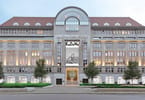The South Pole may be one of the most remote places on Earth, but new figures show increasing numbers of tourists are heading there.
Arrivals at the bottom of the world quadrupled from 40 in the 2003-04 season to 164 last year, statistics from the United States base at the pole say.
“They come and they come,” US National Science Foundation representative Jerry Marty told The Antarctic Sun.
The US Antarctic Program was trying to work out how to manage the influx, he said. “It’s one of those unknowns we hadn’t expected.”
The first humans to arrive at the South Pole were Roald Amundsen and his party, on December 14, 1911.
Now it is home to a giant US base, filled with 250 scientists and support staff in summer. It has a basketball court, gym and hydroponic greenhouse for growing vegetables, all of which is off-limits to tourists.
Kiwi adventurers Kevin Biggar and Jamie Fitzgerald trekked almost 1200 kilometres to the South Pole in January last year. They stayed 36 hours, before abandoning a return trip because of a hamstring injury to Mr Fitzgerald. “It was amazing to be at the bottom of the world,” Mr Fitzgerald said.
American scientists at the pole had been very hospitable and showed them around. But he said the South Pole was no longer a pristine environment: “To be honest, it’s a bit like a big port. There’s some pretty big machinery around, all these containers and a huge runway.”
There has also been a jump in tourists going to Antarctica as a whole.
Over 1992-93, 6700 tourists visited the region, many aboard cruise ships. By the summer of 2007-08, that had quadrupled to 29,530, sparking warnings of an environmental and human catastrophe if a big cruise ship sank.
WHAT TO TAKE AWAY FROM THIS ARTICLE:
- Arrivals at the bottom of the world quadrupled from 40 in the 2003-04 season to 164 last year, statistics from the United States base at the pole say.
- By the summer of 2007-08, that had quadrupled to 29,530, sparking warnings of an environmental and human catastrophe if a big cruise ship sank.
- The US Antarctic Program was trying to work out how to manage the influx, he said.






















